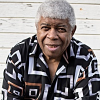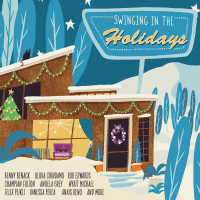Home » Jazz Musicians » Herbie Mann
Herbie Mann
The world according to flutist and composer Herbie Mann was a utopian musical paradise where jazz is made up of of Afro-Cuban, Middle-Eastern, R&B, and nearly every other kind of music. In the 1960s, he discovered Brazil's bossa-nova; in the 1970s, he even found disco rhythms in jazz.
Unlike most of his contemporaries in jazz, when Mann began playing flute in 1940s he had no forefathers to learn from, no pioneers of jazz flute to idolize. He was forced to look elsewhere—both inside and outside of jazz—to develop his approach to jazz and the flute. Among numerous musical influences, Mann was particularly drawn to rhythms and melodies from South America and the Caribbean.
Herbie Mann was born Herbert Jay Solomon in Brooklyn, New York, on April 16, 1930. Early in his childhood, Mann was so enthralled with rhythm that he wanted to be a drummer. Instead, a cousin of his mother convinced him to play the clarinet.
In 1948, Mann began serving four years in the army and while stationed in Trieste, Italy, he began playing saxophone in the military band. After his discharge from the service, he saw a jazz scene overflowing with sax players and he fell back on his second instrument, the flute. When the Dutch accordionist, Mat Matthews, told him he was looking for a jazz flute player for the first album by the then unknown Carmen McRae, Herbie immediately jumped at the opportunity and spent days "woodshedding" before going into the studio. With this opportunity he was able to distinguish himself from other players as a jazz flutist, of which there were few.
In 1954, Mann released his first album for Bethlehem Records, “Herbie Mann Plays.” Although at that time he was jamming with bebop innovators like bassist Milt Hinton, drummers Art Blakey and Kenny Clarke, and pianist Tommy Flanagan, Mann was never truly comfortable playing straight-ahead bebop. As he began to bring non-jazz elements into his sound, Mann's flute playing began to sound tougher and more aggressive.
Three years later, Mann made the first of three albums for Verve Records, titled “The Magic Flute of Herbie Mann.” The album featured, "The Evolution of Mann" which became an instant hit on the radio thanks to New York disc jockey, "Symphony Sid" Torin. Mann then formed an Afro-Cuban band with percussionists like Rudy Collins, Ray Mantilla, and Carlos "Patato" Valdez, all from Cuba's legendary Machito Orchestra. Because Mann was able to pay the percussionists more money than what they were making with the other Latin orchestras, a rift was created between Mann and many of the other Latin bandleaders. Eventually, Mann's interest in Afro-Cuban jazz led him to the music's source—Africa. In 1959, the U.S. State Department funded a trip for Mann to visit Africa, after they heard his version of "African Suite."
Read moreTags
McCoy Tyner, George Colligan, Herbie Mann & David Watson

by Joe Dimino
From one of the freshest voices in the Kansas City jazz scene, we kick off the 895th episode with David Watson and his smooth vocal stylings from his 2020 album, The Ludlow Affair. Then, we take a nostalgic turn with the legendary Herbie Mann, whom David had the privilege of knowing during his time at The Showboat in Philadelphia. The journey continues with a lineup of jazz heavyweights delivering fresh new work, including the Yellowjackets, Marius Van Den Brink, George ...
Continue ReadingHerbie Mann: An Amalgamation of Everything

by Bob Kenselaar
[Flauist Herbie Mann was often ahead of the trend with his wide explorations into sounds from everywhere. When I asked him in this 1978 interview where music in general was heading, he talked about a broad mix--"an amalgamation of everything"--which might be a good way to describe Mann's overall career, except that it doesn't account for his own personal, exuberant voice.] Over the last 25 years, Herbie Mann has taken his flute all over the map--literally and figuratively. It's not ...
Continue ReadingHerbie Mann & Phil Woods: Beyond Brooklyn

by George Kanzler
Herbie Mann and Phil Woods met when they were two barely adult beboppers jamming together at a joint called Tony's Bar on Flatbush Ave. in Brooklyn in 1951. A couple years later, Woods would play on Mann's Yardbird Suite LP. They finally shared the front line on an album again with this CD, the last Mann made before he died on July 2, 2003.Beyond Brooklyn is a fine envoi to Mann's career, featuring the flutist in many of ...
Continue ReadingClassic Herbie Mann

by WBGO 88.3FM
For the past 40 years, flutist Herbie Mann has taken the instrument in several different directions, performing in a wide variety of musical styles including straight-ahead and soul and pop-jazz, as well as world music, and most recently Eastern European music. A cancer survivor, Mann's latest project is a crusade for prostate cancer awareness. Brian Delp: Ten years ago you moved out West, to Sante Fe. Herbie Mann: My wife and I just reached that point ...
Continue ReadingHerbie Mann/Bobby Jaspar: Flute Flight

by David Rickert
Flautists are the 98 pound weaklings in the jazz musician crowd, constantly working hard to prove that their chosen instrument has serious jazz credentials. Herbie Mann and Bobby Jaspar were two of the few who made the flute their primary instrument, and both had their moments, Mann as a leader and Jaspar with JJ Johnson. However, Flute Flight, a pairing of the two originally recorded in 1957, never gets off the ground. Before this recording Mann had been successful at ...
Continue ReadingHerbie Mann/ Bobby Jaspar: Flute Flight

by Derek Taylor
Concept albums were all the rage back in the late Fifties, and jazz music was no exception among genres. Popular within this certain niche was the notion of featuring instruments uncommonly featured in lead roles. The result was a flood of records fielded by everything from French horns to accordions to harps. One album cut for the Savoy label featured four of the former instruments in a winsome frontline combination. The modest flute might not seem like such an oddity ...
Continue ReadingThe Herbie Mann-Sam Most Quintet: The Herbie Mann-Sam Most Quintet

by Robert Spencer
There's no use denying it, so I'll confess: I am not a big jazz flute fan. The instrument has always seemed to me to be too slight to power a rhythm section and too breathy to maintain an individual attractiveness. But Herbie Mann and Sam Most have converted me on this unlikeliest of ensembles, a double flute quintet.The Herbie Mann-Sam Most Quintet is a 1956 album of eleven genial, high-spirited tracks featuring Mann and Most trading bright, up-tempo, ...
Continue ReadingPerfection: Herbie Mann - Manteca

Source:
JazzWax by Marc Myers
Herbie Mann was a fascinating artist. Not only was he a masterful jazz flutist but he also crossed over to Latin, funk, soul, bossa nova and rock and pioneered world music. His curiosity and ability to adapt to various styles was almost unrivaled during the 1960s and '70s. One of his most popular Latin-jazz albums was Latin Mann: Afro Bossa to Blues. Recorded in 1965 for Columbia, the album featured Oliver Nelson's Latin-jazz arrangement of Manteca, which was co-composed by ...
read more
Backgrounder: Herbie Mann - Yardbird Suite

Source:
JazzWax by Marc Myers
By 1957, the West Coast jazz scene was firmly established and its musicians were working regularly in Los Angeles' many recording studios. The best ones worked relentlessly cranking out 12-inch LPs. The same was true of New York's jazz scene, where improvisers found themselves in strong demand by leading labels such as Blue Note, Prestige, Savoy and Riverside. That year, six of the finest New York players appeared on Yardbird Suite, an extraordinary album led by flutist Herbie Mann. Recorded ...
read more
Backgrounder: Herbie Mann-Sam Most Quintet

Source:
JazzWax by Marc Myers
Two of the finest jazz flutists in New York in the mid-1950s were united by producer Creed Taylor when he was at Bethlehem Records. The Herbie Mann-Sam Most Quintet was recorded in October 1955 and released in 1956. It featured Herbie Mann, Sam Most (fl), Joe Puma (g), Jimmy Gannon (b) and Lee Kleinman (d). Sam Most had more experience under his belt than Mann at the time, having played with Tommy Dorsey, Shep Fields, Boyd Raeburn and Don Redman ...
read more
Herbie Mann in 10 Tracks

Source:
JazzWax by Marc Myers
Love him or hate him, flutist Herbie Mann was in the groove and on top of just about every major music trend between mid 1950s and the 1980s and paved the way for World Music in the '60s. Admittedly, not all of his albums were great, but he did have a knack for being in the right place at the right time to catch a wave. Here are 10 Herbie Mann tracks through a wide range of music genres: Here's ...
read more
Herbie Mann with Oliver Nelson

Source:
JazzWax by Marc Myers
Herbie Mann was a fascinating jazz figure. The flutist and saxophonist was a dominant player in the 1950s, recording prolifically as a leader and sideman, and always bringing tremendous swing and lyricism to his work. Both of Mann's parents were dancers, so his keen sense of time makes perfect sense. Tall and lean, he became the prototype for beat-generation beboppers, coffee-house bongo players, the folk-jazz hipsters and Greenwich Village VW-driving daddy-o's. Mann also had a eye and ear for the ...
read more
Herbie Mann: Bossa Nova '62

Source:
JazzWax by Marc Myers
Nearly two years after the fall of Cuba in 1959, Congress passed the Mutual Educational and Cultural Exchange Act, which mandated an increase in governmental programs “to enhance mutual understanding between the United States and other countries." Many of those “other countries" were in Latin America. [Pictured above: Herbie Mann] In July 1961, jazz promoter Monty Kay and Alex Valdes produced the American Jazz Festival at the Ritz Theater in Sao Paulo, Brazil. In addition, the touring band of State ...
read more
2005 Cape May Jazz Festival - The Music of Herbie Mann Weekend Schedule

Source:
All About Jazz
Friday, November 11, 2005 7:30PM - 8:30PM Celebrating the Music of Herbie Mann Convention Hall 8:00PM - 9:00PM An Evening with Charlie Hunter Star of The Sea Auditorium 9:00PM - 1:00AM Byther Smith and the Night Riders Cabanas 9:00PM - 1:00AM Gene Ludwig Organ Quartet Carney's Main Room 9:00PM - 1:00AM Joshua Breakstone Trio Carney's Other Room 9:00PM - 1:00AM Dan Faulk Quartet Boiler Room at Congress Hall 9:00PM - 1:00AM Burr Johnson Trio Caf Promenade 9:15PM - 10:15PM Andy ...
read more
The Music Of Herbie Mann Celebrated at the Cape May Jazz Festival Nov 11-13

Source:
All About Jazz
November 10, 2005 To: Listings/Critics/Features From: JAZZ PROMO SERVICES THE MUSIC OF HERBIE MANN NOV 11-13 The 24th Cape May Jazz Festival presented by Bank of America kicks off Friday November 11 honoring the late premier jazz flutist, Herbie Mann....voted Number One jazz flutist for 13 years by Downbeat Magazine. Long before “world music" was coined, Herbie was exploring the rhythms of Africa, India, Cuba, Jamaica and especially Brazil. Mann performed to a sell out crowd at the Cape May ...
read more
24th Cape May Jazz Festival, A Tribute to Herbie Mann, November 11-13

Source:
All About Jazz
The 24th Cape May Jazz Festival presented by Bank of America kicks off Friday November 11 honoring the late premier jazz flutist, Herbie Mann….voted Number One jazz flutist for 13 years by Downbeat Magazine. Long before “world music” was coined, Herbie was exploring the rhythms of Africa, India, Cuba, Jamaica and especially Brazil. Mann performed to a sell out crowd at the Cape May Jazz Festival April 1999 and November 2002. At his last appearance he asked if Cape May ...
read more















































